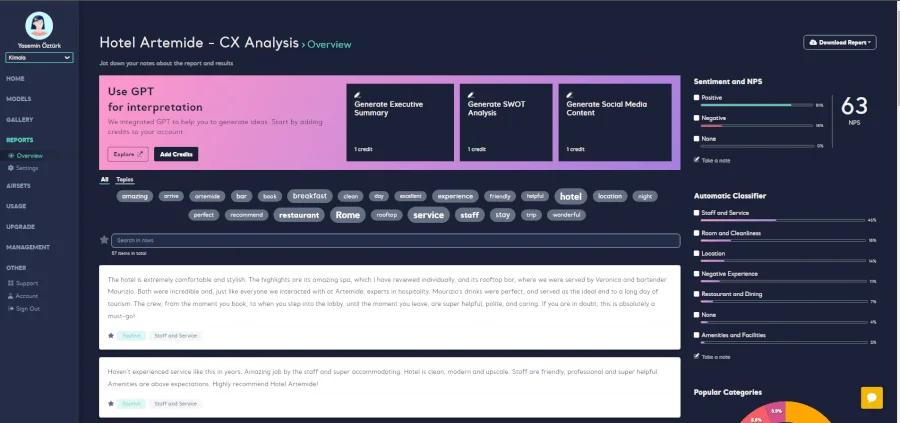How to Create a Seamless Customer Experience Analysis?
Jan 18, 2026 - 16 minute read
In today's digital era, the success of businesses isn't just about having great products and services – it's also about creating a one-of-a-kind customer experience (CX). Think of it like this: customer experience takes a brand from being a run-of-the-mill product provider to becoming a real connection with customers. That's why, these days, everyone's talking about and really putting their minds to the whole customer experience thing.
And you know what? It's not hard to see why this buzz is going on. There's solid proof that brands that focus on boosting CX actually grow faster. Like, seriously – businesses that make customer experience a priority? They're boosting their revenues 1.7 times faster than those that don't bother. Plus, these businesses are cranking up the lifetime value of their customers by around 2.3 times, on average.
But here's the magic part: improving CX isn't just about making existing customers happy. It's also a golden ticket for drawing in fresh faces and building that super important brand loyalty. So, businesses aren't just stopping at providing products or services anymore – they're diving into all sorts of strategies to create and manage killer customer experiences. These strategies are like a whole toolkit, ranging from encouraging awesome experiences that people want to share on digital platforms to dishing out personalized services. At the end of the day, nailing customer experience doesn't just speed up a business's growth – it also sets brands up with a pretty unbeatable edge in the competitive game.
What is customer experience analysis?
Customer experience is all about the feelings, thoughts, and actions that a customer goes through when they connect with a brand. This journey starts from when they first discover a product or service and continues as they buy it, use it, and engage with it in different ways. This experience holds a lot of power – it shapes how a customer sees the brand, how loyal they become, and what reputation the brand holds.
Getting the hang of CX is a big deal for businesses. It's like having a compass that guides them in making customer interactions even better, all the time. When customers have a good experience, they smile a bit brighter, stick around a bit longer, but a not-so-great experience can push them away. And when something awesome happens to a customer, they can't help but tell everyone they know, bringing new friends to the brand.
The cool thing is, businesses use customer experience analysis to really get what customers want and like. It's like asking customers for their thoughts, checking if they're happy, finding out if there are any bumps in the road, and spotting chances to make things even cooler. They can do this by asking questions, having group chats, studying what customers say, and even doing some number crunching.
Now, if a brand is just starting out and hasn't met any customers yet, they can still learn a ton from the competition and what's hot in the industry. It's like watching others play the game and figuring out the best moves. By doing this, the brand can build a solid plan for making customers feel awesome when they do come around.
So, here's the bottom line: CX is a major player in business success. Grasping it lets you craft incredible journeys for your customers, boost loyalty, and turn them into your biggest fans. By tapping into different research methods, like checking out the competition, even newbie businesses can gather insights to help them make the right moves and improvements. In this age of endless choices for customers, going the extra mile to deliver an unforgettable customer experience can set you apart and steer your business towards long-lasting success.
How to make customer experience analysis?
Gathering and truly understanding customer feedback has turned into a must-do, but let's cut to the chase: What's the smartest way to tackle this?
Alright, picture this: to cultivate a seriously tuned-in company vibe, you've got to make gathering feedback from all corners of the digital world a real priority. It's like planting the seeds for a culture that's all about valuing every little bit of input. Now, let me lay out a bunch of nifty feedback strategies that can help you build up this amazing culture of active listening:
Journey feedback, which is intricately tied to NPS surveys, gauges the overall sentiment of your customers towards a brand, product, or service. Interaction feedback, mirroring the concept of a CSAT survey, assesses a customer's perception at a specific touchpoint. For instance, this could involve evaluating a customer's response following an interaction with a support chatbot. By conducting this type of assessment, you gain insights into customer reactions to a particular feature, enabling you to differentiate between effective and ineffective aspects.
Social listening, often referred to as passive listening, encompasses the process of capturing customer sentiments from the vast expanse of the internet. This entails monitoring online reviews, Twitter conversations, Facebook discussions, and more.
Real-time listening encompasses the capability to promptly tune in and respond to customer interactions as they happen, regardless of where these interactions occur. This might involve leveraging built-in tools like chatbots or engagement on social media platforms.
Once you've embraced these diverse listening tactics, you'll find yourself with a treasure trove of data at your fingertips. This data comes in various flavors – star ratings ranging from 1 to 5 , and those thoughtfully penned open-ended reviews . But here's the twist: the way you roll up your sleeves and analyze this data is like the secret sauce.
And hey, this is where Kimola's AI-powered enchantments come into play. Imagine having a digital assistant that's a whiz at dissecting customer feedback. With our fancy AI customer feedback analysis tools, you can unravel the essence of what customers are pouring into those text-based reviews. It's like a backstage pass to deciphering insights, and the best part? It all unfolds right then and there, in real-time and on a grand scale.
But wait, the thrill doesn't stop there. Want a sneak peek at the magic in action? Say hello to our customer feedback classifier – it's like a decoder ring for customer responses, revealing the main themes hidden within. Or, meet our sentiment classifier – think of it as a mood detective, revealing the emotions hidden behind those lines. Both tools are your secret weapons for decoding and quantifying the wealth of customer feedback.
Let's take a look at the analysis of customer reviews for Hotel Artemide. We collected these reviews from various sources such as Tripadvisor, Trustpilot, and Google Business Reviews using Kimola's Chrome extension, Airset Generator. Now, it's time to move on to the next step.
We need to drag and drop the Excel file containing the data into Kimola. Then, we select the automatic classifier and sentiment classifier. And there you go, the magic begins.

The results are truly impressive! Kimola analyzed the customer reviews, identified relevant tags, and classified the comments. According to this analysis, it's evident that nearly half of the Artemide customers specifically mentioned staff and services. Based on the analyzed data, it wouldn't be wrong to say that 8 out of 10 customers who visited Artemide hotel spoke positively about it.

Based on this insightful experience with Kimola, brands can harness its power to enhance customer experiences in remarkable ways. By utilizing Kimola's sophisticated tools, brands can tap into a goldmine of customer feedback from diverse platforms like Tripadvisor, Trustpilot, and Google Business Reviews. This comprehensive approach offers a holistic view of customer sentiments, preferences, and pain points.
With Kimola's intuitive interface, the process is seamlessly streamlined. Brands can effortlessly integrate their customer feedback data by dragging and dropping Excel files into Kimola. Through the automatic classifier and sentiment classifier, the analysis journey begins, uncovering the hidden gems within the data.
The benefits are clear: Kimola provides a deep understanding of customer sentiments, allowing brands to identify patterns, trends, and focal points of discussion. Armed with these insights, brands can tailor their strategies, refine their services, and address pain points to create a more satisfying customer journey.
For instance, if nearly half of the customers at Hotel Artemide consistently highlight the staff and services, the hotel management could focus on further enhancing these aspects to build upon its strengths. Furthermore, the fact that 8 out of 10 customers expressed positive sentiments about their stay showcases an opportunity for Artemide to amplify its marketing efforts and capitalize on its satisfied customer base.
In essence, Kimola opens the door for brands to not only analyze but also optimize their customer experiences by translating raw feedback into actionable insights. By incorporating these insights, brands can shape their offerings to meet customer expectations, foster loyalty, and drive growth in a competitive market landscape.
Why customer journey needs sentiment analysis?
Customer journey is a process that involves understanding the various touchpoints and interactions a customer has with a business or brand, from initial awareness to post-purchase support. Sentiment analysis is the practice of using natural language processing (NLP)and machine learning (ML) techniques to determine the emotional tone or sentiment expressed in a piece of text, whether it's positive, negative, or neutral. Combining customer journey mapping with sentiment analysis can provide valuable insights for several reasons:
- Understanding Emotional Engagement: Sentiment analysis helps businesses understand the emotional responses and reactions of customers at different touchpoints throughout their journey. This insight allows companies to identify which interactions generate positive or negative emotions, helping them gauge the overall emotional engagement of customers.
- Improving Customer Experience: By analyzing sentiment, businesses can pinpoint areas of the customer journey where customers are expressing frustration, dissatisfaction, or confusion. This information is crucial for making improvements and enhancements to these specific touchpoints, ultimately leading to a better overall CX.
- Tailoring Marketing Strategies: Sentiment analysis can reveal the emotional triggers that prompt customers to engage with a brand, make a purchase, or share their experiences. This information can be used to refine marketing strategies, creating content that resonates with customers on an emotional level.
- Real-time Feedback: Sentiment analysis can be performed on social media, customer reviews, and other online platforms where customers share their opinions. This provides businesses with real-time feedback about customer sentiment, allowing them to address issues promptly and adapt their strategies accordingly.
- Competitor Analysis: Analyzing sentiment not only for your own brand but also for competitors can provide insights into how your brand's customer experience and sentiment compare. This information can guide your competitive positioning and help you differentiate your offerings.
- Predicting Customer Behavior: Sentiment analysis can also help predict future customer behavior. For example, identifying negative sentiment during the onboarding process might indicate a higher likelihood of customer churn. By addressing these issues, businesses can proactively prevent customer loss.
- Personalization and Customization: Sentiment analysis can aid in creating personalized experiences. By understanding the sentiment of individual customers, businesses can tailor their interactions, offers, and recommendations to align with customers' emotional preferences.
- Measuring Campaign Effectiveness: When launching marketing campaigns, sentiment analysis can help measure their impact. By analyzing sentiment before and after a campaign, businesses can assess whether their efforts have had the desired emotional impact on customers.
- Employee Training and Support: Sentiment analysis can extend beyond customer interactions to internal communication. By analyzing employee sentiment and feedback, businesses can identify areas where employees might need more training or support, ultimately affecting the customer experience they provide.
Incorporating sentiment analysis into the customer journey mapping process allows businesses to move beyond objective metrics and understand the subjective experiences and emotions of their customers. This insight is invaluable for creating a more empathetic and customer-centric approach to business strategies.
Start your 7- day free trial to get sentiment analysis from Kimola.
Why customer experience needs data classification?
Customer experience benefits significantly from data classification as it offers a powerful means to understand, manage, and enhance customer interactions and feedback. Data classification, a technique powered by NLP and ML, enables businesses to automatically categorize and analyze textual data based on the sentiment, intent, or themes expressed. This capability is crucial for unlocking actionable insights from a vast amount of unstructured data, such as customer reviews, feedback, and social media conversations.
Data classification is instrumental in deciphering the nuances of customer emotions and preferences. By automatically categorizing customer comments, reviews, and messages, businesses can identify trends, sentiment patterns, and emerging issues. This insight helps prioritize areas for improvement, address customer concerns, and proactively respond to feedback. Additionally, data classification allows for personalized communication and tailored marketing strategies by understanding the emotional context behind customer interactions. By grouping similar content, businesses can swiftly address customer inquiries and provide more relevant solutions. Ultimately, the synergy between customer experience and data classification empowers businesses to listen to their customers at scale, adapt to their needs, and foster lasting loyalty through meaningful interactions.
How to choose a customer experience analysis tool?
Choosing the right customer experience analysis tool is crucial for gaining meaningful insights into customer interactions and improving overall satisfaction. Here are the key factors to consider when making your choice:
- Functionality and Features: Assess the tool's capabilities. Look for features like sentiment analysis, text classification, trend identification, and topic categorization. Ensure it can handle unstructured data like customer reviews and comments effectively.
- Accuracy and Reliability: Check the tool's accuracy in sentiment analysis and classification. Reliable results are essential for making informed decisions. Look for tools that offer high accuracy rates and allow you to fine-tune models for your specific industry or domain.
- Ease of Use: The tool should be user-friendly and accessible to both technical and non-technical users. A user-friendly interface and intuitive navigation make it easier for your team to work with the tool effectively.
- Customization: Every business is unique. Choose a tool that can be customized to match your specific industry, brand voice, and customer interactions. Customization ensures that the insights provided are aligned with your business context.
- Scalability and Performance: Consider whether the tool can handle the volume of data you generate and analyze. It should be scalable to accommodate your growing data needs while maintaining performance and responsiveness.
- Integration Capabilities: Ensure the tool can integrate seamlessly with your existing systems, databases, and customer relationship management (CRM) platforms. Compatibility with your current tech stack is essential for efficient data flow and analysis.
- Support and Training: Look for tools that offer comprehensive customer support and training resources. Responsive support ensures you can address any issues promptly, while training materials help your team make the most of the tool's capabilities.
- Cost and Value: Evaluate the pricing structure and consider the value the tool brings to your business. A tool might have all the features you need, but it's essential that it fits within your budget.
- Reviews and Reputation: Research user reviews and the tool's reputation in the market. This provides insights into real-world experiences and can help you gauge the tool's effectiveness.
By carefully evaluating these factors and aligning them with your business goals, you can select a customer experience analysis tool that empowers you to enhance customer satisfaction, drive improvements, and make data-driven decisions.
At this point, brands can leverage advanced customer feedback analysis tools like Kimola to streamline the process of automatically categorizing customer feedback. With the use of advanced data analytics tools, brands can efficiently categorize this data for sentiment analysis and further categorize it based on specific topics, from "Design" and "Price" to "Quality" and beyond. With the use of the latest text analytics techniques for automatic classification, subsequent exploration of these categorized insights becomes significantly more feasible. This enables businesses to leverage the power of machine learning to gain data-driven insights, improve their products and services, as well as scrutinize and resolve customer feedback.
See how Kimola rocks comparing to Monkeylearn and Chattermill.
E-commerce Customer Experience Analysis
Amazon, the biggest player in the online retail world, has an incredible variety of products – we're talking over 12 million of them! Every single day, there are countless customers sharing their thoughts about these products, both the good and the not-so-good, through reviews. These reviews are like a treasure trove, especially for folks who are thinking about selling stuff on Amazon. They're a real market research goldmine. Understanding and really getting into these customer reviews can genuinely help brands make their products and services even better, and make the whole shopping experience a lot more awesome. There are plenty of tools out there to help with this, but here's a little secret tip: You can totally try Amazon Review Analyzer out for free. So, let's do this together – let's dive into the world of customer experiences. Imagine, if your thing is selling shoes, delving into what customers feel and experience with your kicks can be a total game-changer.
Here's the scoop on how to scrape and analyze them step by step: Start off by grabbing the Amazon product link you want to explore. Then, head over to this link. Paste your Amazon link into the box they've got waiting for you there. Hit that start button and sit tight for a few minutes while the magic happens. Before you know it, you'll have a shiny report to check out. It's like peeking behind the curtain of customer experiences!

Here is the report of the reviews for "Knock Off Jordans" on Amazon. The report includes both positive and negative reviews, the Net Recommendation Score, content analysis, as well as prominent topics in customer feedback. In this context, we observe that our customers share their experiences regarding the quality, authenticity, and appearance of our shoes.
Customer Experience vs Customer Journey
Customer Experience (CX) and Customer Journey are two essential concepts in the realm of customer-centric strategies, each focusing on distinct aspects of the customer's interaction with a brand. CX refers to the emotional perceptions and overall feelings that customers develop over the course of their relationship with a business. It encompasses the totality of interactions, from the first touchpoint to ongoing support, and emphasizes creating positive emotions, loyalty, and lasting impressions. CX delves into the customer's holistic experience, considering factors like product quality, customer service, brand reputation, and the emotional impact of each engagement.
On the other hand, the Customer Journey is a detailed depiction of the customer's path as they navigate through various stages of engagement with a brand. It zooms in on the specific touchpoints, interactions, and decision-making points along the way. This concept focuses on understanding the customer's steps from initial awareness to post-purchase engagement, identifying pain points, optimizing touchpoints, and ensuring a seamless process. By mapping the Customer Journey, businesses gain insights into where customers might encounter challenges, allowing them to strategically enhance individual interactions to create a smoother overall experience.

In essence, while CX deals with the emotions and overall sentiment customers associate with a brand, the Customer Journey centers on the specific touchpoints and stages that contribute to shaping that experience. These concepts work hand in hand to build a comprehensive customer-centric strategy that fosters loyalty, advocacy, and lasting positive impressions.








